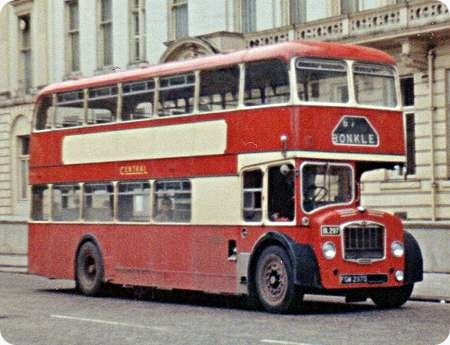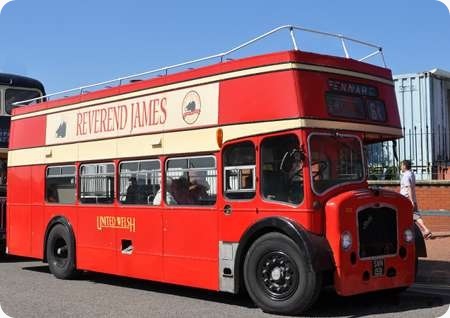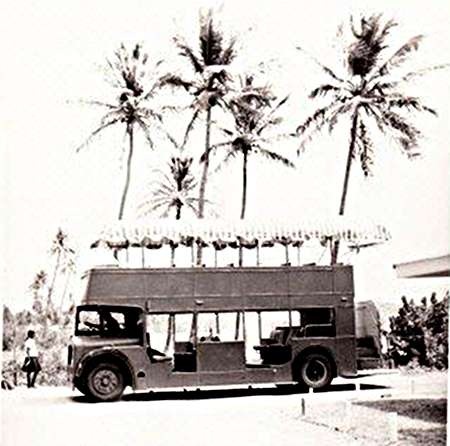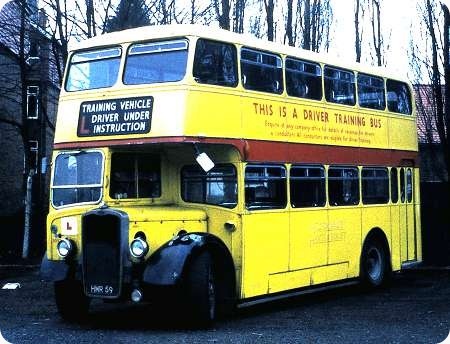
Wilts & Dorset Motor Services
1952
Bristol KSW5G
ECW L55R
Here is a view of HMR 59, a Bristol KSW5G with ECW bodywork. By the time of this view, the 1952 vehicle had been relegated to training duties. She’s seen in the yard of the Hants & Dorset depot in Southampton, in March 1975. By this time, NBC amalgamations were in full swing, and the Wilts & Dorset fleet name was soon to disappear.
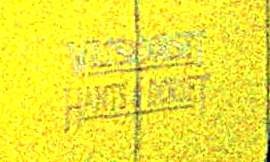
The view is of particular interest in that both fleet names appear, in Tilling style, on the side.
Photograph and Copy contributed by Pete Davies
01/08/13 – 18:24
I well remember the changeover to Hants and Dorset in the Salisbury area. A typical NBC waste of money. Everyone I knew always said they were travelling on "the Wilts".
Under different management we have W&D back but in the Salisbury area they call themselves "Reds" and in Poole/ Bournemouth they are known as "More".
Goodness knows what this is supposed to mean.
Paragon
03/08/13 – 14:28
I know what you mean about names. locally we have buses run by ‘Et Cetera’ in the Chobham area. It sounds like they were an afterthought!
Whatever is wrong with good old-fashioned no-nonsense titles, that did what it said on the tin?
Grahame Arnold
04/08/13 – 06:47
Grahame. I think you’ll find that the outfit you are talking about is the illiterate ExCetera – from Croydon – who seem to be cleaning up in Surrey at the moment. Living in Ottershaw, I am often in and around Chobham but have not seen them in service there yet. Working regularly around Croydon, I have seen quite a lot of them – and in the intervening territory.
David Oldfield
04/08/13 – 14:52
David
Thank you for the correction. I also live in Ottershaw (26 years now) so we may have crossed paths at some point. I have seen the ‘Ex Cetera’ brand name on the Chobham-Woking route but there are no doubt others, as you say.
Grahame Arnold
05/08/13 – 08:04
I was in Guildford yesterday and there was a Buses Excetera vehicle passing me. There also appears to be a Coaches Excetera arm as well, the website not only giving a London Phone contact number, but also a Milan one! they do seem to cover the Croydon Epsom, Guildford corridor.
Chris Hebbron
05/08/13 – 10:33
Chris. I believe the coaches arm came first but I also suspect that it was a pre-existing company known by another name.
David Oldfield
05/08/13 – 17:42
FWIW, I read on the web that the Excetera came out of Croydon Coaches, but when I rang the latter, I was told that the Excetera had come out of EPI Coaches, also of Croydon and London.
Chris Hebbron
06/08/13 – 06:11
As a Croydonian whose wife comes from Guildford, and who spent many formative years in the bus industry at Reigate with LT(CB&C) and LCBS, and at Aldershot with the "Tracco", together with years of moonlighting with Tillingbourne and North Downs, I prefer to remember the bus network in those parts as it was before the devastating Black Death known as Deregulation. Nowadays, whole swathes of industry, not just transport, are besotted with ‘rebranding’, for which they surrender stupendous sums to shiny suited simpletons in the "marketing" sector, and, in return, receive offerings of extreme absurdity that appear to emanate from the ludicrous world of Edward Lear. Grahame asks why things cannot now do what they say on the tin. Sadly, and increasingly, they often do – the tin has very little in it. Public service is now so shaky that one concludes it must be a punishable offence.
Roger Cox
06/08/13 – 08:23
I worked in Guildford, early ’60’s, working at Bridge House (long gone), by the station. We nicknamed it Bridge House over the River Wey! I’ve visited the town periodically over the years (wife grew up in Woking). I also seem to recall Safeguard, too. Also, an LT presence, with GS’s and RLH’s at Onslow Street. Is it still there?
Chris Hebbron
06/08/13 – 08:27
Grahame. Saw one in Woking yesterday morning. Roger, don’t hold back. [No, I agree with you all the way.]
David Oldfield
06/08/13 – 11:49
Chris, Guildford town centre (many locals continue to be under the misapprehension that the place is a city by virtue of its cathedral) was "remodelled" in the ’70s around the river Wey crossing area with a brutish, concrete abomination of a one way system that, amongst other things, obliterated the fine Farnham Road bus station. Onslow Street bus station over a footbridge on the other side of the river disappeared too, and Guildford now has its decidedly basic Friary bus station adjacent (inevitably) to a big shopping complex of that name on the site of the old Friary Meux Brewery. Mercifully, the old Dennis building at the junction of Bridge Street and Onslow Street has survived the devastation. Progress? (Another thing – have you noticed that policemen look younger these days?)
Roger Cox
06/08/13 – 18:00
Roger, having spent many years involved with marketing from both sides of the fence, as it were, I can’t let your remarks on "shiny suited simpletons" pass without comment.
Marketing – as opposed to sales, is a very tenuous art, perhaps even a dark art. Over nearly 50 years I’ve seen it evolve (or should that be dissolve) from a tool to solidly position products and services in the mind of the buyer to a cure all for poor management decisions, badly thought out products and lack of understanding of the needs of the potential market.
Unfortunately water finds its own level and if you are running a marketing company, an ad agency or a design house and you find that poorly conceived ideas are just as much accepted and command just as much income as those which take real thought, testing and development, the tendency is to take the line of least resistance.
Equally to blame as poor managers who are prepared to accept lazy or shoody marketing are the purchasers of the products and services so presented. There seems to be a trend in these islands where, as long as the product is cheap enough, doesn’t take effort to access or is perceived to be offered by a large enough institution, people take a laissez faire attitude.
Just look at some of the very poor, banal and often totally irrelevant product advertising on TV. What sort of management allows an ad with a strap line "92% of 121 women agree". More to the point, what sort of end user accepts such rubbish and even makes a purchasing decision on such an ad? Unfortunately far too many.
This attitude extands into far more important matters: banks, for instance who change their terms and conditions at will to their benefit yet, if you as the other party to the contract want to make changes, you are told you can’t. Then the same bank will run an ad supported marketing campaign praising its customer friendly attitude and encouraging you to discuss your finances "in branch" – YUK!
So, don’t blame those who provide the tools for such mediocrity, they are just trying to make a living and responding to the feedback they get from those that buy their services. That attitude may be morally bankrupt but morality in business can be a sure fire way to bankruptcy.
Rant over!
Phil Blinkhorn
06/08/13 – 18:02
Policemen may indeed look younger but this retired one didn’t when he looked in the mirror this morning!
The country must be getting very dangerous as all the coppers go about in pairs. Some of them look so young I am tempted to say to them what the Colonel said to the young officer in Dad’s Army "Haven’t you got a comic to read boy?"
Seriously though they do a difficult job and in my experience it has always been a case of Lions led by Donkeys which also sums up much of our dear old country today.
Back to the posting. I do miss the sight and sound of Bristols trundling round the streets of Salisbury.
Paragon
07/08/13 – 06:55
Thx for the update, Roger. So another town has been partially spoiled in the name of progress. You mention Guildford being thought of as a city, but many thought it the county town, too. Maybe it is now, with Kingston being lost to Greater London! Damn Edward Heath for his county medddling!
I do know that Woking, a pleasant enough town in the 1970’s, is really ruined these days! But I digress.
Chris Hebbron
07/08/13 – 06:56
Phil, I accept all your comments on the matter of marketing. Ultimately, the client has to bear the blame for accepting trashy publicity and absurdly exaggerated product description. I, too, have gazed upon television advertising in bewilderment as product promotion soars to stratospheric heights of improbability and idiocy. You will have a better knowledge than I of the costs of each individual form of media advertising, but, when a telly advert screeches on for several minutes at outrageous cost without giving a clue to its ultimate product USP, then one wonders what measure of expenditure control is exerted at the client company. Branding has become a particular nonsense, and one suspects that some of the smaller clients are being bamboozled by professional marketeers into accepting names that belong more in a Doctor Who script or a Tolkien novel than in the real world of product placement. Sententious twaddle infects almost everything we see around us nowadays. The guy across the road works for the local housing association, which has adopted the utterly meaningless moniker "Luminus" (serves ’em right that it is usually referred to as "Loony Mouse"). His van bears the utterly vacuous slogan, "Demonstrating a more excellent way of doing business". Quite apart from the uselessness of this blurb – the van isn’t demonstrating anything – whoever thought that up knows nothing of English grammar; you cannot have varying degrees of excellence – it is an absolute. Yet we see this sort of gibberish in advertising all around us now. End of my rant. I must press a cold flannel to my forehead. I must sound like King Lear screaming into the face of the storm.
Roger Cox
07/08/13 – 08:27
Kingston is still the County Town following the failure to decamp to Woking a year or two back. Despite the abomination that is the "Friary area", Guildford is still a "nice town" in other parts of the centre – that cannot be said of Woking which has an even worse "bus station" (the road outside the railway station). As a pilcock, sorry pillar, of the Church of England, for many years I was under the illusion that a Cathedral imposed city status on a town. I was only disabused of this quite recently. There is at least one plaque on Guildford High Street extolling the virtues of the City of Guildford. Well, it would be better than some recently ennobled towns!
David Oldfield
07/08/13 – 13:07
Roger, in explaining the evolution and descent of much of marketing into mediocrity I failed to mention that, like you, I rage against such rubbish.
Another nonsense, foisted on us "for our protection", is the Data Protection Act. Example: talking on the phone to a UK government department this week I told the person on the phone at the start of the conversation that, after speaking to me, my wife had a query and I would pass the phone to her. During both conversations it must have become evident we were in the same room, that we have been married 42 years and that were exchanging comments to check information asked of both of us.
My wife then asked a particular question which would have involved the person on the phone divulging information about me. This was 20 minutes into the call. She had to pass the phone to me so I could give permission for the question to be answered. Total b****y nonsense.
Back to buses. The rear doors on the KSW, whilst no doubt a welcome addition for conductor and passengers, spoil the look of the vehicle. The width of the short bay and the jack knife doors are too similar making the rear of the lower deck look unbalanced compared to the rest of the well proportioned design.
Phil Blinkhorn
07/08/13 – 13:08
Well, this view has invited some interesting comments, has it not!!!!!! How a County Town can be other than in it’s ‘home’ County is beyond me. One of the early forms of Local Government Reogranisation – one of the rejected ones – was suggesting that Lancaster should leave Lancashire and go into Westmorland! County Town isn’t always the administrative centre of the County Council, of course – Appleby was the County town of Westmorland, but Kendal was the Admin centre. At least they are/were in the same County! Blackburn is another Cathedral town, but it isn’t a "City". I’m not too sure about Arundel . . . Chelmsford is another place that has long been considered a City – the local football club even has that name – but it was ‘elevated’ last year as part of the Golden Jubilee.
Pete Davies
07/08/13 – 14:13
I like the way it says ‘This is a Driver Training Bus…..’ on the side, and on the front it shows ‘Training Vehicle’. It always rankled me when Yorkshire Rider boldly proclaimed our training buses to be Driver Training Units. Units ? They weren’t learning to drive a Unit – it was a bus for goodness sake ! They didn’t change their name to FirstUnit.
John Stringer
07/08/13 – 15:30
Don’t give Wirst Bus ideas, John.
Arundel is different, Pete – it’s a Roman Catholic Cathedral and never in the same mix of cathedral/city arguments.
David Oldfield
07/08/13 – 15:30
Many of these comments remind me of my last years before retirement. For seventeen years I was a driver with one of the major supermarket chains, for the last seven of those I was a DSA registered HGV driving instructor/assessor, and as such I was regarded as management. All the instructors at the 20 odd depots used to say that there are two phrases that cover everything from incompetence to downright stupidity, they were ‘Company policy’ and ‘Operational requirements’
Ronnie Hoye
07/08/13 – 17:24
The County Hall for Surrey is still in Kingston, though that town is now within a London Borough, having been annexed by the GLC in 1965. I think that this situation is unique, unless, of course, someone on the OBP knows different (and I bet that proves to be the case). It does seem remarkable that Surrey CC has been unable to find suitable premises for relocation in 48 years.
Roger Cox
08/08/13 – 07:27
It may be unique at county level, Roger, but certainly not at lower levels. The offices of North East Derbyshire District Council are within the Borough of Chesterfield, and when I lived in Newport in 1969 I was surprised to find the offices of Magor and St Mellons Rural(?) District Council there. In both these cases, however, the offices are/were geographically central to the strangely-shaped administrative area, despite being located outside it!
Peter Williamson
10/08/13 – 06:01
Two examples of ‘market-speak’ that irritate are ‘logistics’ and ‘solutions’. Haven’t the foggiest idea what either looks like, but there seem to be increasing numbers of trucks (logistics) and vans (solutions) carrying such items nationally. Presumably solutions are smaller or lighter than logistics. Whatever happened to the good old no nonsense word ‘haulage?’ As we know, in the bus and coach industry much heritage has been lost with the demise of such appendages as Traction, Automobile, Road Car, Motor Services, Omnibus etc. These titles of character and distinction have sadly been brushed aside in favour of the bland term ‘Travel’, or such corporate regional suffixes as ‘SouthEast’ and ‘The Shires’. Wonder how long it will be before a certain design and marketing consultancy will have us believe that bus operators are no longer bus operators, but actually ‘providers of local mass travel solutions’.
Brendan Smith
10/08/13 – 09:24
The word you need Brendan is "transit". I’m sure Google used to use this on their travel directions, but it now says "Public Transport" presumably because people thought that was a route for white vans seeking logistics solutions. Logistics means we have GPS and know which layby you’re holed up in: solutions means we go very fast so the thing you forgot to send will still arrive.
Joe
10/08/13 – 18:33
In a similar vein, have you noticed that new roads are always named "Way" – never road, street, lane, avenue, drive, crescent or (a special Nottingham favourite this) Boulevard.
Stephen Ford
10/08/13 – 18:34
On the topic of logistics, the use of the word by transport companies is legitimate where you are dealing with certain types of haulage.
Without getting too technical or digressing too far, logistics is the art or science (a bit of both really) of ensuring goods, equipment or personnel arrive where they are required, only when required and are fit to be used/take up their role on arrival.
Originally a military concept, it has been applied to the shipment of critical items around the world using multi-modal transport, often through specialised hubs and can see an item in the course of its journey being transported by road air and water. There are specialists in areas from Formula One to oil rig equipment but the most well known true logistics companies are FedEx, DHL, UPS and TNT who, apart from transporting packages have worldwide contracts to move sensitive equipment and data for major corporations and governments in a way that ordinary post and parcel handling would not offer.
Industry’s demand for continual production without the need to hold large stocks of components spawned the idea of "Just In Time Delivery" which created the need for much of the logistical planning that goes into haulage today.
Even the delivery of greengrocery to your local supermarket from the point of origin in, say, Kenya or the Caribbean in a state where it is fresh, has a reasonable shelf life and can be consumed days after purchase, is far more complex today than just haulage from point A to point B.
Phil Blinkhorn
10/08/13 – 18:35
Once upon a time, when the universe was young, and a long lost language called English was spoken in the land, the term ‘logistics’ meant either a branch of mathematics, or the planned organisation of troops, armaments, supplies and transport for an advancing or retreating army. Transport, or as it is now seemingly forever to be known, ‘transportation’, is just one element in the complex package that constitutes logistics. The people that carry goods in vehicles from A to B are simply hauliers, whatever nonsense they choose to display on their lorries (though even these things are now to be called ‘trucks’). Taking up Brendan’s point, I think that the solution for mass travel must surely be the water on which a passenger carrying ferry or canal barge floats. In a world blighted by pretentious marketing piffle, the solution that we all need is a return to the language of Shakespeare and Doctor Johnson. I am not holding my breath.
Roger Cox
11/08/13 – 06:46
I always thought that TNT meant Tomorrow Not Today.
Paragon
12/08/13 – 19:23
Thanks Joe, I think you are right about transit – it flows much better than travel in the ‘strapline’ (now there’s another new word to conjure with!). Thank you too Phil for your comments as to the true meaning of logistics. As you state, the modern art of ‘just in time delivery’ is much more involved than traditional haulage, and there does appear to be a big difference between the two. However, the waters are muddied by the pretentions of some operators whose vehicles carry the ‘logistics’ title, when they should really be proudly displaying the word ‘haulage’ instead.
Brendan Smith
13/08/13 – 06:19
Brendan, you are correct about the pretentions of some hauliers. Strap line is hardly new. Originating in newspapers it describes a secondary headline or caption and Dickens, as a newspaper editor, certainly knew the term. It was adopted by the advertising industry in the early part of the 20th century.
Phil Blinkhorn
13/08/13 – 06:20
Phil, going back to your comment about the KSW’s platform doors, I think ECW may have been dabbling with improving the design at some point. Early KS/KSWs originally had the quarter bay ahead of the entrance panelled over, but on later models the quarter bay was glazed. In either case, with an open platform the design looked balanced as you say. However, with platform doors fitted and closed, if the bay was panelled, a ‘thick pillar’ effect resulted between the fourth bay and the first door glass. If the quarter bay was glazed, the result was the ‘three window’ effect you describe. The same thing affected the LD Lodekka when fitted with platform doors. However, both it must be admitted were still very handsome designs. In order to ensure perfect nearside balance on either model, I suppose the only answer would be to leave the platform doors open at all times!
Brendan Smith
 Vehicle reminder shot for this posting
Vehicle reminder shot for this posting
16/08/13 – 14:35
A piece of totally useless trivia for you, Stephen, and nothing what so ever to do with the original subject. It would take far too long to list them all, but within historical boudaries of the City of London, you will find Squares and Alley’s, names ending in Lane – Side – Gate – Wall – Street Etc, and single words such as Barbican – Eastcheap – Poultry, but no ‘Roads’. However, with the boundary changes of 1994, part of Goswell Road in Islington became EC1 so technically it is now part part of the City, but it is not within The Square Mile.
Ronnie Hoye
16/08/13 – 18:31
Thanks Ronnie – I do totally useless trivia !
Stephen Ford
21/08/13 – 06:33
A London EC post code does not indicate that the place is in the City.Fifty odd years ago when I was at school there Goswell Road and nearby City Road had EC1 postal addresses.
Incidentally the Tower of London has an EC3 post code but is not in the City.
Paragon
